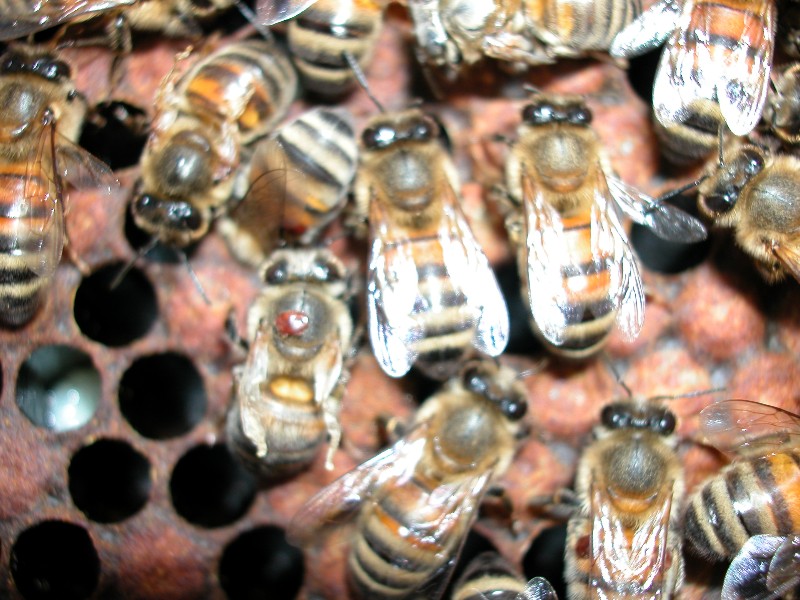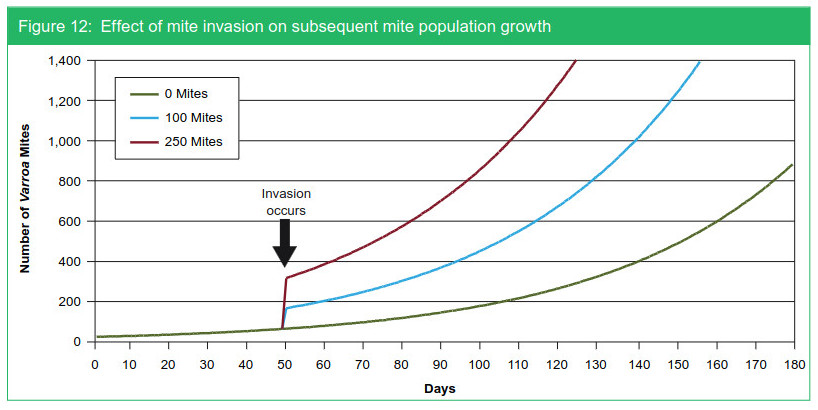Honeybee Diseases - Varroasis
Varroa - currently a most persistent problem for beekeepers the varroa mite, Varroa destructor, is an external parasite of the honeybee Apis mellifera and feeds on the bees haemolymph (blood). Its natural host is the Asian honeybee Apis cerana which has evolved with the mite to develop a natural resistance. It has spread to the European honeybee by beekeepers taking colonies to the Far East to improve honey production. There was a natural transfer of the mite and beekeepers then moved the infested colonies around the world eventually reaching the UK in 1992 where it is now widespread and its management routine practice.
Download the Varroa Info Sheet and the Integrated Pest Management plan to obtain a printable version of Varroa information, detection and treatment methods for your records.
Recognition
Image Courtesy The Animal and Plant Health Agency (APHA), © Crown Copyright

Bee with Varroa destructor mite on thorax, also showing effects of Deformed Wing Virus transmitted by the mites..
Varroa destructor - is a member of the Arachnidae - a group containing spiders and other mites. The adult female mite is a reddish brown colour, oval in shape and measures about 1.1mm X 1.6mm and has 8 legs. On close inspection it is possible to see the mites in drone cells, on drone larvae and on adult bees with the naked eye.
Life Cycle
Adult female Varroa mites enter a brood cell just before it is capped. Drone cells are preferred and the drone brood produces a kairomone (smell) which is more attractive to the mite than that produced by the worker brood. The mite squeezes past the larva and becomes immobile, immersed in the larval food at the bottom of the cell. Only the breathing tubes (peritremes) are exposed. Once the cell has been sealed and the brood food consumed by the larva, the mite is released and then pierces the exoskeleton of the larva to feed on its haemolymph. Egg laying begins about 60 hours after the cell has been sealed. The first egg to be laid is haploid (7 chromosomes) and develops into a male. Subsequent eggs laid at about 24 hour intervals are diploid (14 chromosomes) and develop into females. The actual timing may vary due to external effects. A 6 legged larva develops in the egg and hatches into an 8 legged protonymph. This then moults into a deutonymph and finally to the adult form. Average numbers of female mites developing are as follows:
- Worker cell 2.2
- Drone cell 4.2
Recent work at the Central Science Laboratory (CSL) indicates an average of 1.45 viable female mites from a worker cell. The male mite does not eat and its sole purpose is to mate with its sisters and it then dies and remains in the cell. The mated females live on the young host bee until they enter cells to reproduce. In the summer mites live about 2-3 months but much longer in the winter. When they are on the adult bee they are described as phoretic. In summer mites can manage 2 reproductive cycles producing ~ 8 daughters if using drone brood.
Effects on Apis mellifera colonies - Apis mellifera has no natural defences against the Varroa mite which feed on larvae and adult bees weakening them and spreading other harmful pathogens throughout the colonies. Left untreated, colonies of bees will eventually die. It is unlikely that any signs will be noticed until the colony has been affected for about 3 years. It is very difficult to see the mite on the adult bee as it lives in the intersegmental region of the lower abdomen. As it breeds in the sealed cell it cannot be seen unless the cell is opened and the contents examined. As the infestation progresses small malformed bees begin to appear and brood patterns are affected. Signs of colony collapse:
- A sudden decrease in adult bees
- Bees with deformed wings and abdomens
- Numerous mites on the remaining bees and in brood cells
- Abnormalities of brood Bald brood
- Poor brood pattern
- Neglected and dead brood
- Discoloured and partly removed brood
Colony Collapse
There is no definitive level of infestation at which a colony will collapse. The overall health of the colony, existing presence of viruses and pathogens, natural tolerance, and environmental factors will influence a colonies ability to withstand varroa pressure, and for how long. Untreated, mite numbers will however continue to build to the point that collapse will eventually occur, generally within 1 -3 years. It is widely agreed that below 1000 mites per colony is a level that colonies in the UK may be able to cope with over a season. Above this threshold there will be a significant impact on colony health and function leading to collapse.
Natural Reproduction Image © Crown copyright 2020

Mite Increase
Mite numbers increase two ways in the colony. Firstly through natural reproduction as previously described, and secondly through mite invasion. Mite invasion can occur at any time during the season when adult bees are active and can increase numbers significantly and to a critical level in a short time. There is a higher risk of invasion where colony numbers are high and where hives are closer together and robbing occurs.
Mite Invasion Image © Crown copyright 2020

Detection
Varroa is likely to be present in all colonies, beekeepers should be vigilant throughout the year testing for the levels of infestations. There are several methods and procedures used in testing for Varroa.
- Examination of the floorboard / hive debris - This method is not the most reliable particularly when infestation is light. The small number of mites which drop are easily missed.
- Uncapping Brood - This is done on the drone brood during a normal colony inspection. Note - that if the mites are very young they will not be as dark as the adults and easily missed. A frame of drone foundation can be used in the brood chamber to make examination easier and can also be used as a method of control.
- Mite Drop Test - This is a reliable means of estimating mite levels - with a sticky paper insert on the floor use a proprietary miticide in the brood chamber and leave for 24 - 48 hours. Examine the insert carefully for the presence of the mites. This is an ideal method for testing swarms and if positive can be used as a treatment.
Monitoring - Vigilance is important with all honeybee diseases. Check all apiaries and colonies regularly for health and suspect any colonies that are not thriving where there is no already known reason. Colonies that are not performing well or die out should be examined thoroughly and sealed to prevent robbing and spread of any diseases present. Once the mites have been detected the use of an open mesh Varroa floor can be used to determine natural mite drop. Regular examination of brood can also be used. Monitor more than 1 colony in the apiary to make sure you have a representative result. The benefits of monitoring are to show if your control methods are working.
Open Mesh Floors - Mites cannot survive long without contact with their hosts. Mites falling or rubbed off comb fall through the mesh floors and out of the hive. Use of an Open Mesh Floor serves to stop these fallen mites re-entering the hive and reduces the overall mite population while also reducing debris on the hive floor, improving hive ventilation, and discouraging other pests such as wax moth. Note: While Open Mesh Floors are an integral part of varroa management and can be used with a tray to measure mite drop, they are not sufficient on their own and must be used with other methods of mite control.
Comb Trapping - The queen is caged for 9 days on three combs in succession. These are left in the hive for a further 9 days to allow the mites to enter. The combs with the mites trapped in the sealed brood are removed and destroyed. To reuse the combs place them in a deep freeze for a couple of days to kill the brood and mites. Then uncap and wash the contents out of the cells.
Drone Brood Removal - Using sheets of drone foundation in the brood chamber or a super frame to allow drone comb to be drawn underneath it causing the queen to lay drone brood. This is more attractive to the mite and once capped can be removed and the contents disposed of. Like the method above there is a danger that if you are unable to remove the sealed comb and it hatches you will have increased the mite population rather than reduced it.
Treatment
Chemical Controls - A range of both hard chemical (active ingredient fluvalinate, flumethrin, amitraz e.g.) and soft chemical (active ingredient formic acid, oxalic acid, thymol e.g.), sublimation, varroacides are available and should be used for effective Varroa control. Only use approved varroacides / miticides and ensure products are used only in accordance with manufacturers instructions to achieve the best results and avoid possible resistance build up. Each product has its own merits, check with your local beekeeping suppliers for up to date approved products.
Bio-technical Controls - Open Mesh Floors. Mites cannot survive long without contact with their hosts. Mites falling or rubbed off comb fall through the mesh floors and out of the hive. Use of an Open Mesh Floor serves to stop these fallen mites re-entering the hive and reduces the overall mite population while also reducing debris on the hive floor, improving hive ventilation, and discouraging other pests such as wax moth.
Bio-technical Controls -Comb Trapping. The queen is caged for 9 days on three combs in succession. These are left in the hive for a further 9 days to allow the mites to enter. The combs with the mites trapped in the sealed brood are removed and destroyed. To reuse the combs place them in a deep freeze for a couple of days to kill the brood and mites. Then uncap and wash the contents out of the cells.
Bio-technical Controls -Drone Brood Removal. Using sheets of drone foundation in the brood chamber or a super frame to allow drone comb to be drawn underneath it causing the queen to lay drone brood. This is more attractive to the mite and once capped can be removed and the contents disposed of. Like the method above there is a danger that if you are unable to remove the sealed comb and it hatches you will have increased the mite population rather than reduced it.
Combination Therapy - Many of the methods described above can be used in conjunction with one another using Integrated Pest Management, which is highly recommended and more straight forward than it sounds using a combination of bio-technical and chemical controls.
Resistance - Resistance is when the mite will not respond to the treatment and is the beekeepers worst nightmare! To reduce the risk:
- Always follow the manufacturers guidelines
- Apply treatments only when needed
- Always use the full recommended dose
- Always remove varroacide strips at the end of prescribed treatment
- Do not re-use strips (except as a diagnostic aid)
- Alternate treatments using unrelated authorised products whenever possible
Integrated pest Management - This is a well tried, tested and recommended practice throughout agriculture and uses a variety of controls applied throughout the season. The benefits are:
- Control at several points makes it harder for the mites to reach harmful levels.
- Including a bio-technical method can slow mite reproduction and reduce the need for varroacides
- Using 2 or more unrelated varroacides will delay the development of resistance
- Control strategy can readily be adjusted to reflect changing infestation levels
Disease prevention is best practice, maintain good apiary housekeeping and bee husbandry:
- Always maintain strong and vigorous colonies that show good hygienic tendencies, re-queen from known healthy colonies.
- Always maintain a high level of hygiene in all your beekeeping practices
- Carry out methodical health inspections on a regular basis, checking for brood disease particularly in spring and autumn.
- Never transfer combs between colonies without checking for brood diseases
- Systematically replace old brood combs in your hives melting down the old comb to maintain clean and healthy brood.
- Never bring colonies or equipment into your apiary without establishing their origin, condition, and disease status.
- Sterilise any secondhand equipment or hive components before introducing them into your apiary
- Discourage drifting and robbing in the apiary
- Suspect stray swarm health until you know otherwise
- Report any incidence of disease or suspicious conditions immediately to your local association
Vectors
Varroa mites cling on to and travel with adult bees wherever they go, and move from hive to hive, transferring to other bees and colonies.
- Robbing - When a colony is severely affected it becomes a target for robbers. Not only do they take any stores but also pick up large numbers of mites.
- Drifting - Poor apiary design and location will allow young bees to drift into neighbouring colonies. This is particularly important with drones as are they are accepted into any colony.
- Bee Migration - Bees from collapsing colonies abscond from their own hive with the robbers and increase the mite load in the robbers hive.
- Migratory Beekeeping - Moving colonies around the countryside to exploit nectar flows such as heather moors and seasonal OSR has great potential to rapidly spread all diseases. Colony health should be checked before deciding if it is safe to move them.
- Swarming - A swarm from an infested colony will always carry mites with it. It is essential to test any swarm for the mite and treat it before introducing it to the apiary.
- Feral Swarms - Swarms from feral colonies are no more likely to be free than those from managed colonies but can spread the mite naturally by 3-5km per year.
- Beekeepers - Careless manipulative management by the beekeeper can transfer affected bees to other colonies in the apiary and to other apiaries. Migratory beekeeping can cause a rapid spread throughout a country.
Try the Honeybee Diseases Quiz
About the 'My Beekeeping Kit' website.
Contact Iain Dewar for enquiries, suggestions, corrections and contributions for improving the notes. Always welcome!